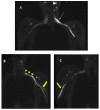Nerve MR in the Differential Diagnosis of Neuropathies: A Case Series from a Single Center
- PMID: 37568411
- PMCID: PMC10419791
- DOI: 10.3390/jcm12155009
Nerve MR in the Differential Diagnosis of Neuropathies: A Case Series from a Single Center
Abstract
In the present study, through a case series, we highlighted the role of magnetic resonance (MR) in the identification and diagnosis of peripheral neuropathies. MR neurography allows the evaluation of the course of nerves through 2D and 3D STIR sequences with an isotropic voxel, whereas the relationship between nerves, vessels, osteo-ligamentous and muscular structures can be appraised with T1 sequences. Currently, DTI and tractography are mainly used for experimental purposes. MR neurography can be useful in detecting subtle nerve alterations, even before the onset of symptoms. However, despite being sensitive, MR neurography is not specific in detecting nerve injury and requires careful interpretation. For this reason, MR information should always be supported by instrumental clinical tests.
Keywords: magnetic resonance neurography; peripheral nervous system; peripheral neuropathy.
Conflict of interest statement
The authors declare no conflict of interest.
Figures









References
-
- Boerkoel C.F., Takashima H., Garcia C.A., Olney R.K., Johnson J., Berry K., Russo P., Kennedy S., Teebi A.S., Scavina M., et al. Charcot-Marie-Tooth disease and related neuropathies: Mutation distribution and genotype-phenotype correlation. Ann. Neurol. 2001;51:190–201. doi: 10.1002/ana.10089. - DOI - PubMed
Publication types
LinkOut - more resources
Full Text Sources

